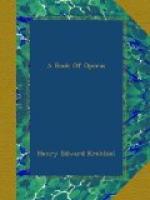There are other mediaeval poems which deal with the story of Lohengrin, more, indeed, than can or need be discussed here. Some, however, deserve consideration because they supply elements which Wagner used in his opera but did not find in Wolfram’s poem. Wagner went, very naturally, to a poem of the thirteenth century, entitled “Lohengrin,” for the majority of the incidents of the drama. Thence he may have drawn the motive for the curiosity of Elsa touching the personality of her husband. Of course, it lies in human nature, as stories which are hundreds if not thousands of years older attest; but I am trying, as I have been in preceding chapters in this book, to account for the presence of certain important elements in Wagner’s opera, and so this poem must also be considered. In it Lohengrin rescues Elsa, the Duchess of Brabant, from the false accusations of Telramund, the knight having been summoned from Montsalvat (or “Monsalvasch,” to be accurate) by the ringing of a bell which Elsa had taken from a falcon’s leg. The knight marries her, but first exacts a promise that she will never seek of him knowledge of his race or country. After the happy domestic life of the pair has been described, it is told how Lohengrin overthrew the Duke of Cleves at a tournament in Cologne and broke his arm. The Duchess of Cleves felt humiliated at the overthrow of her husband by a knight of whom nothing was known, and wickedly insinuated that it was a pity that so puissant a jouster should not be of noble birth, thereby instilling a fatal curiosity into the mind of the Lady of Brabant, which led to questions which Lohengrin answered before the emperor’s court and then disappeared from view. From “Der jungere Titurel,” another mediaeval poem, came the suggestion that the mysterious knight’s prowess was due to sorcery and might be set at naught if his bodily integrity were destroyed even in the slightest degree. In the French tale of “Le Chevalier au Cygne,” as told in the “Chansons de geste,” you may read the story of Helyas, who was one of seven children of King Oriant and Queen Beatrix, who were born with silver chains around their necks. The chains being removed with evil purpose, the children turned into swans and flew away—all but one, Helyas, who was absent at the time. But Helyas




